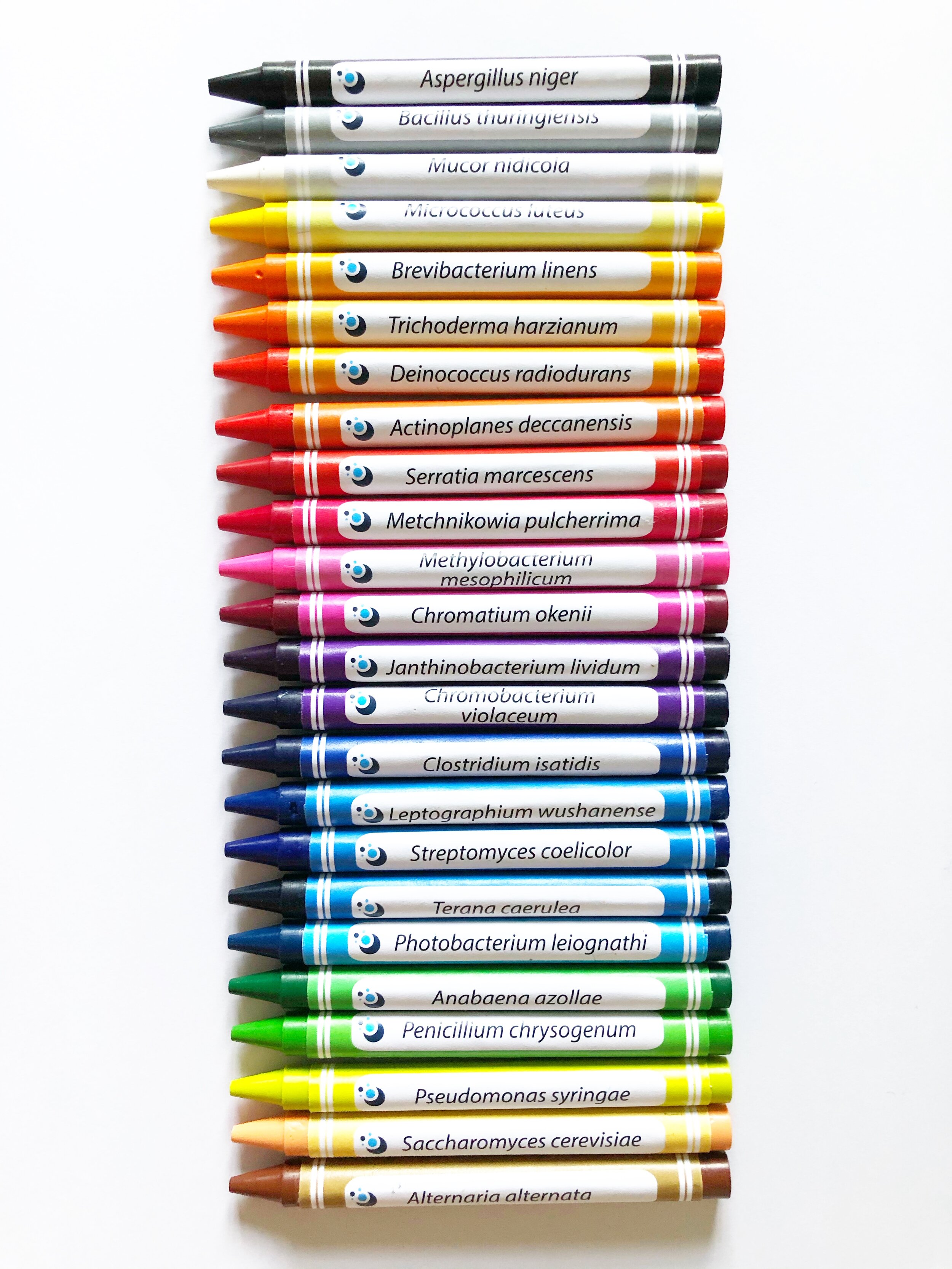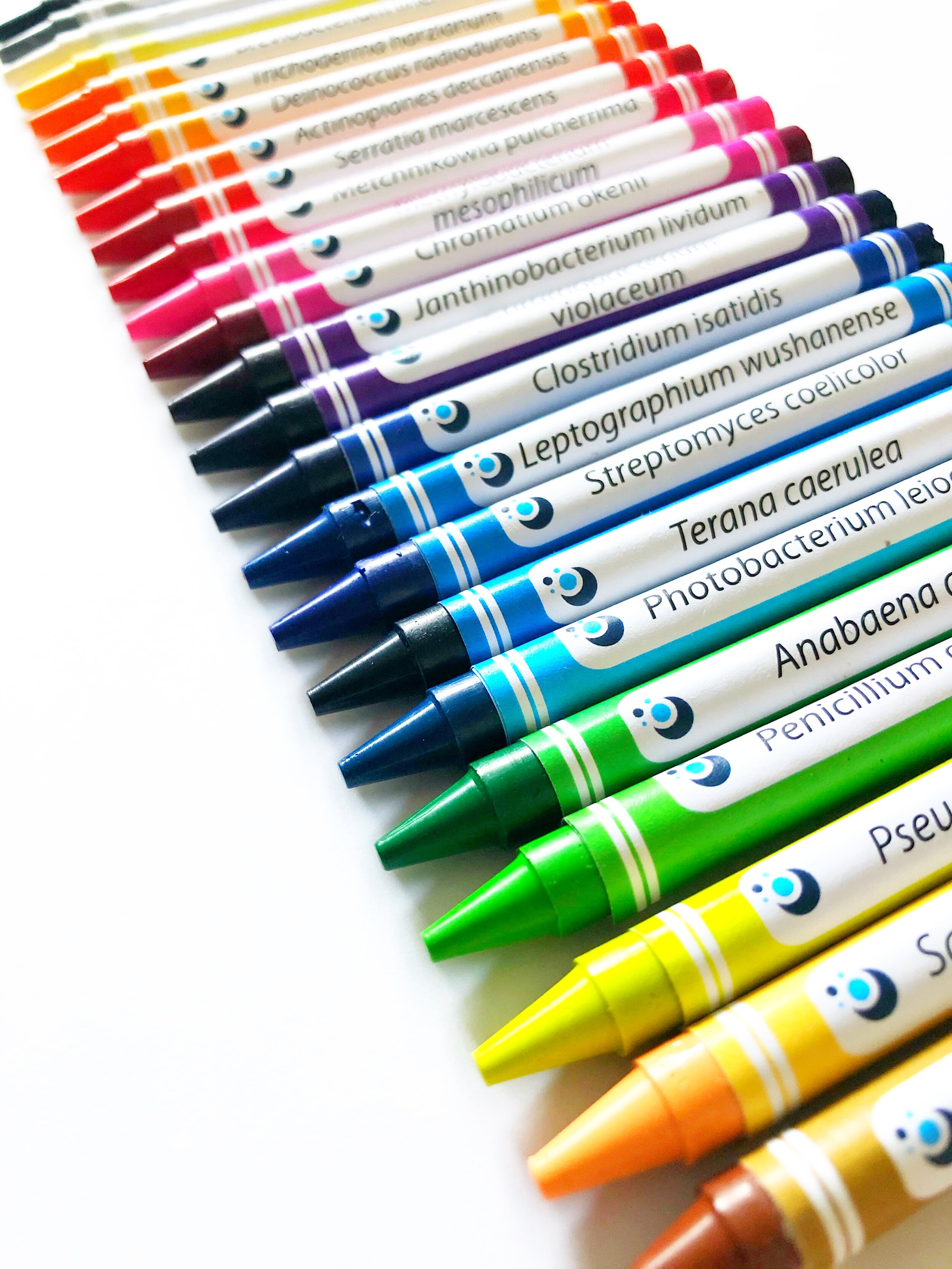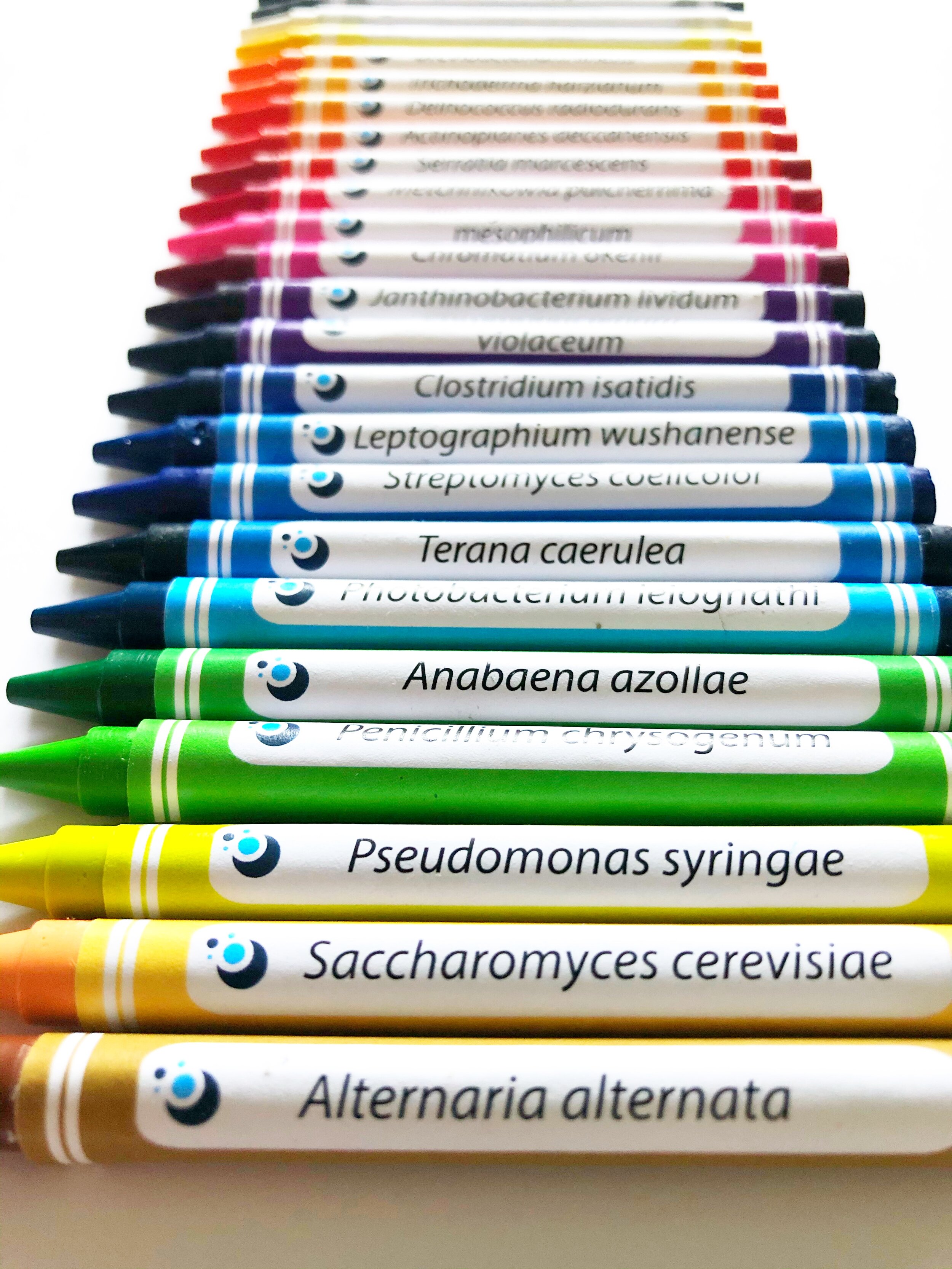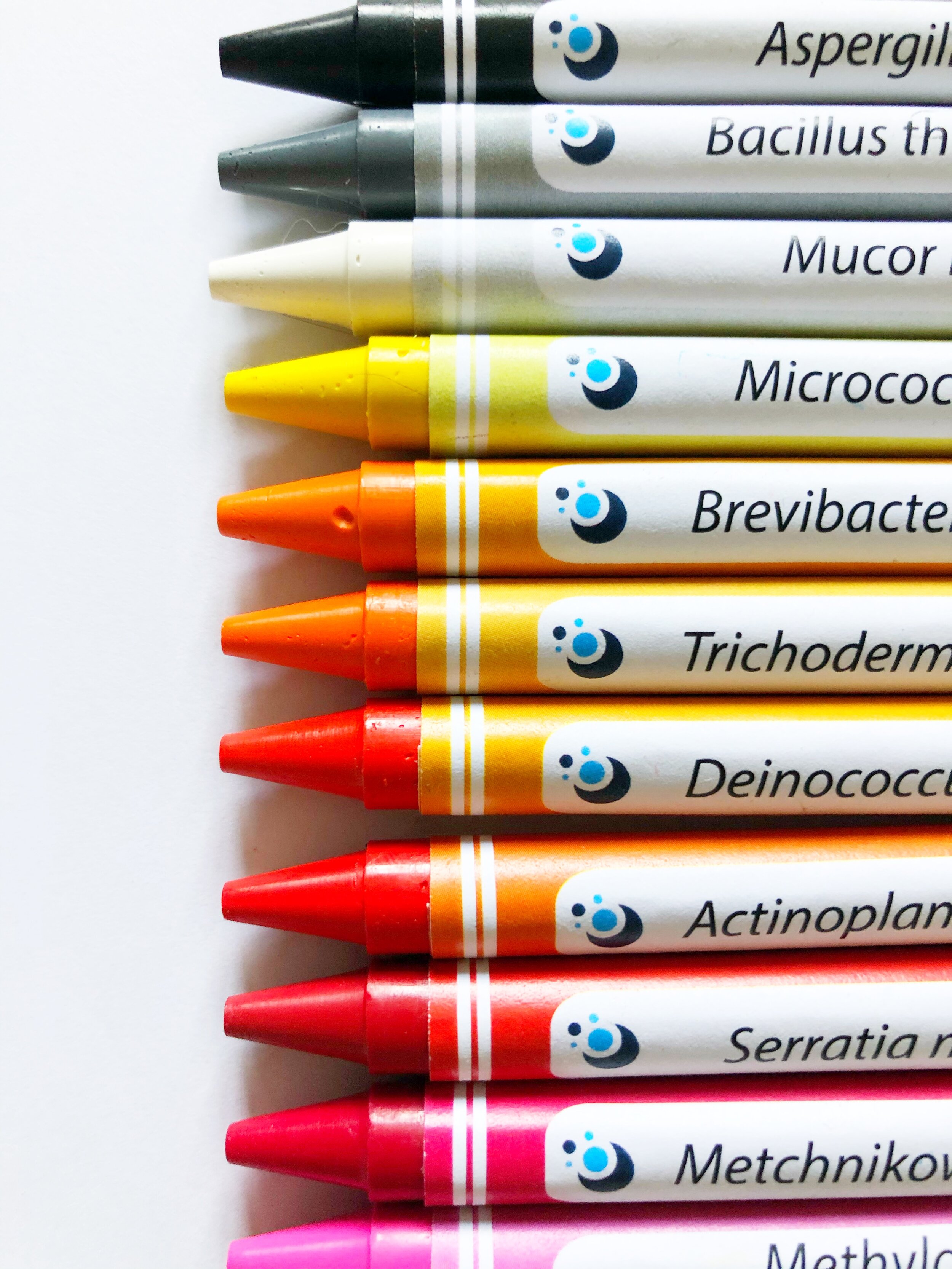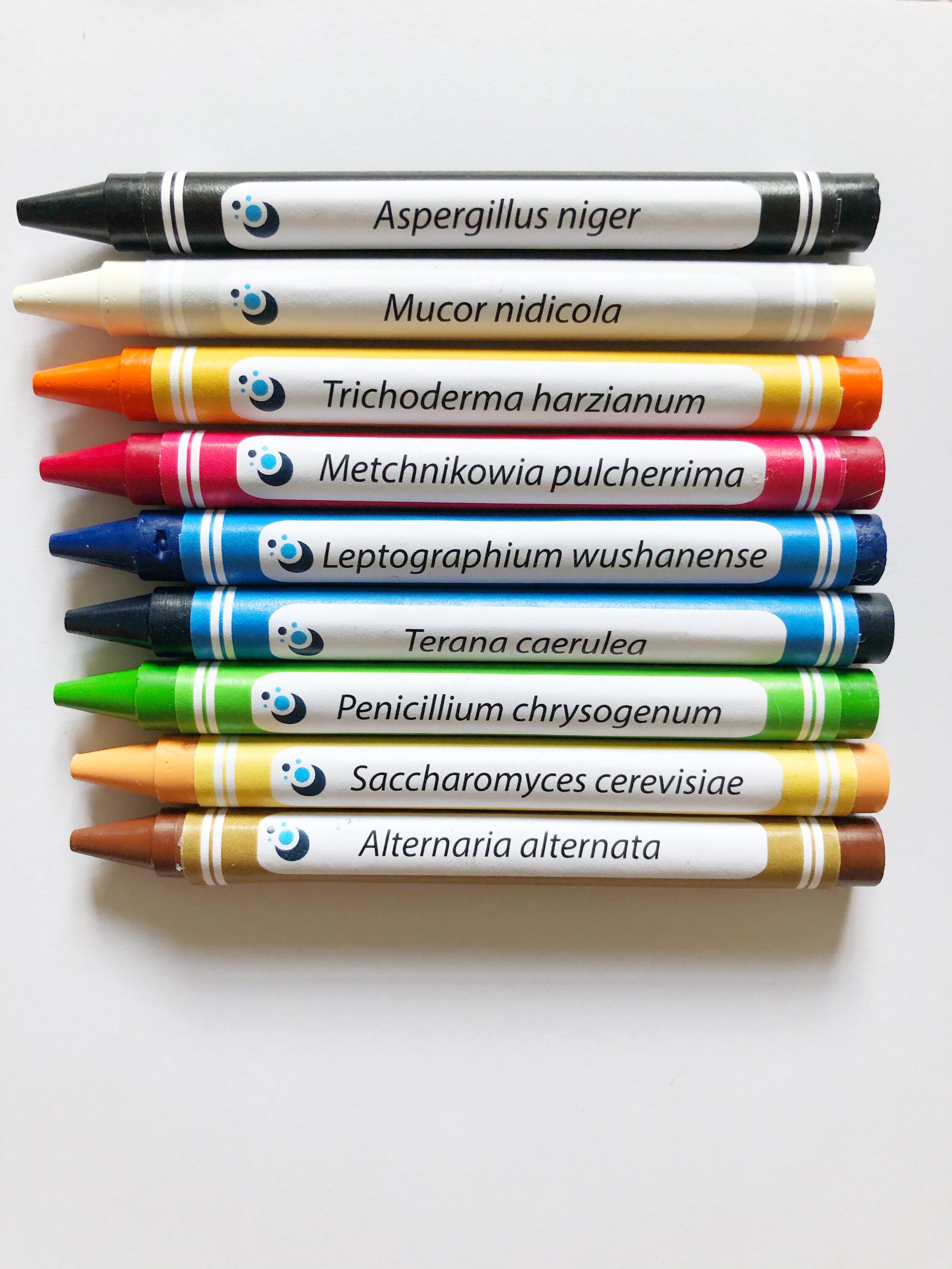
Microbe Crayon Project.
When you think of microbial growth, what colors do you imagine?
It is likely the green of mildew, the brown of rot, or the white of sore throat pustules. It is likely not the cerulean of the soil microbe that makes our antibiotics, the cotton candy pink microbe that produces life-saving cholesterol-lowering medications, the orange fungus that helps plants stay healthy, the midnight black of the fungus that makes vitamins for us, or the unctuous white of the microbe that makes sourdough taste so tart and lovely.
The microbes around us naturally produce a rainbow of colors. To display this with some whimsy, I originally gave a set of 48 Crayola(R) brand crayons a make-over, relabeling them with the microbes that create this biological palette.
The project went a bit viral, and soon became part of a Fortune 500 company’s engagement campaign. Now it is available for you under a Creative Commons BY-NC-ND 4.0 International license.
This project includes labels for 24, 12, and set of 8 crayons. There is also a guide providing information on the human applications of these microbes, and links to images of the microbes’ natural colors. This is just a glimpse into the microbes that make our world colorful.
Welcome to the colors of your biological cosmos!
The Guide
Watch the video to see how to remove the old labels (by soaking in warm, soapy water for ~15 minutes), and then apply the new microbe labels with a glue stick. Keep watching for hints related to education activities associated with these crayons. Don’t forget to print out the Crayon Label Key and Box Label to learn what microbe is which color. Enjoy!

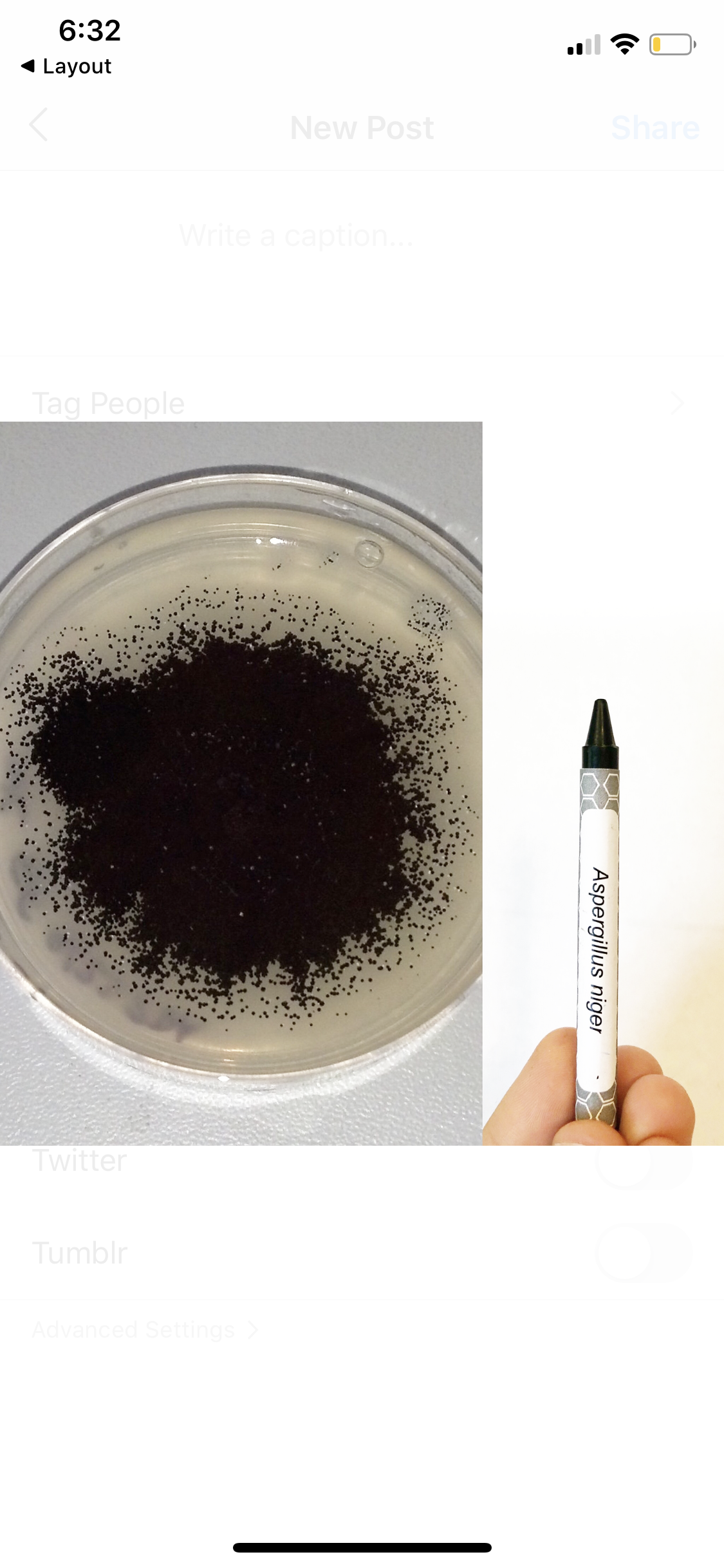

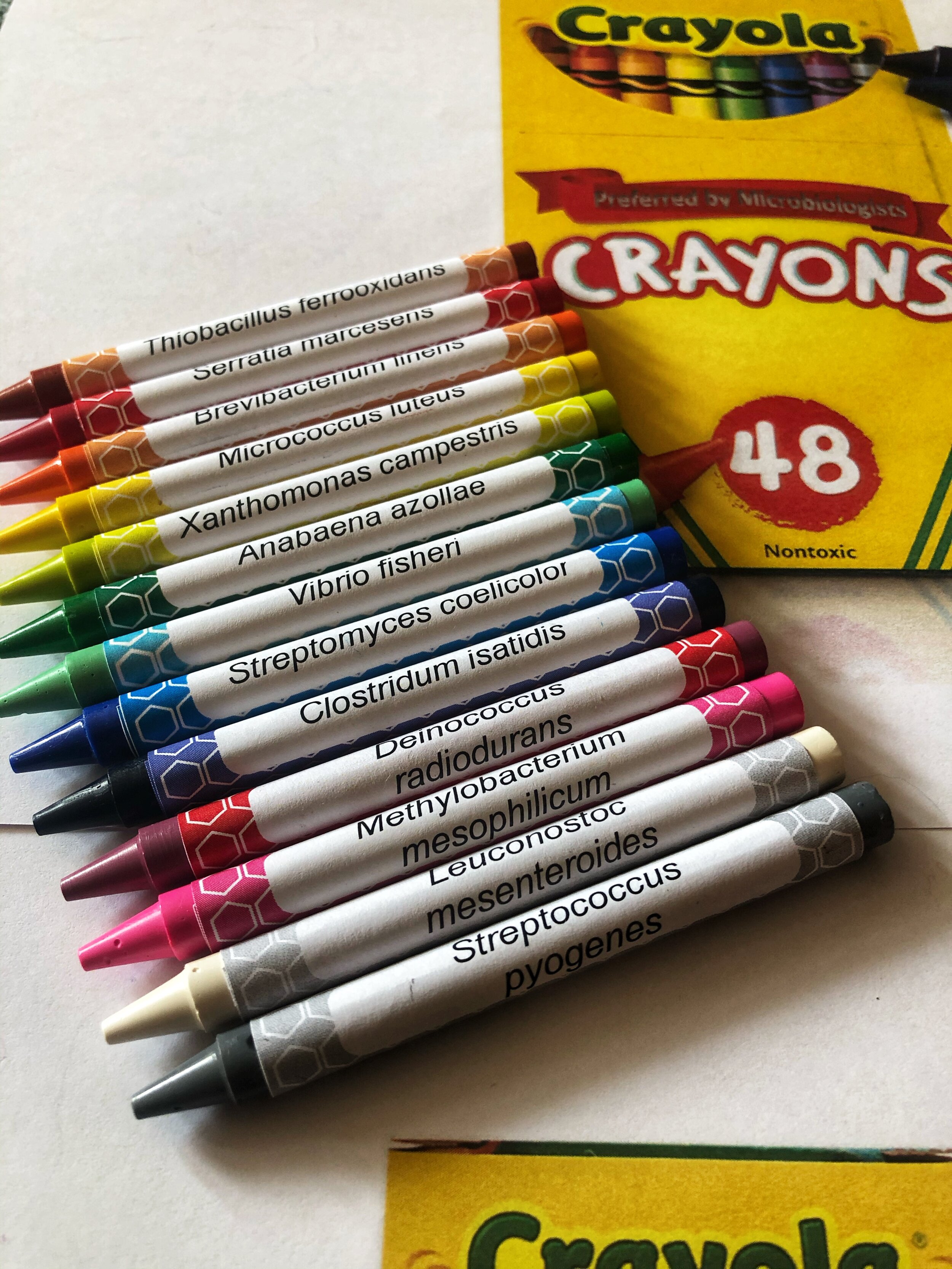
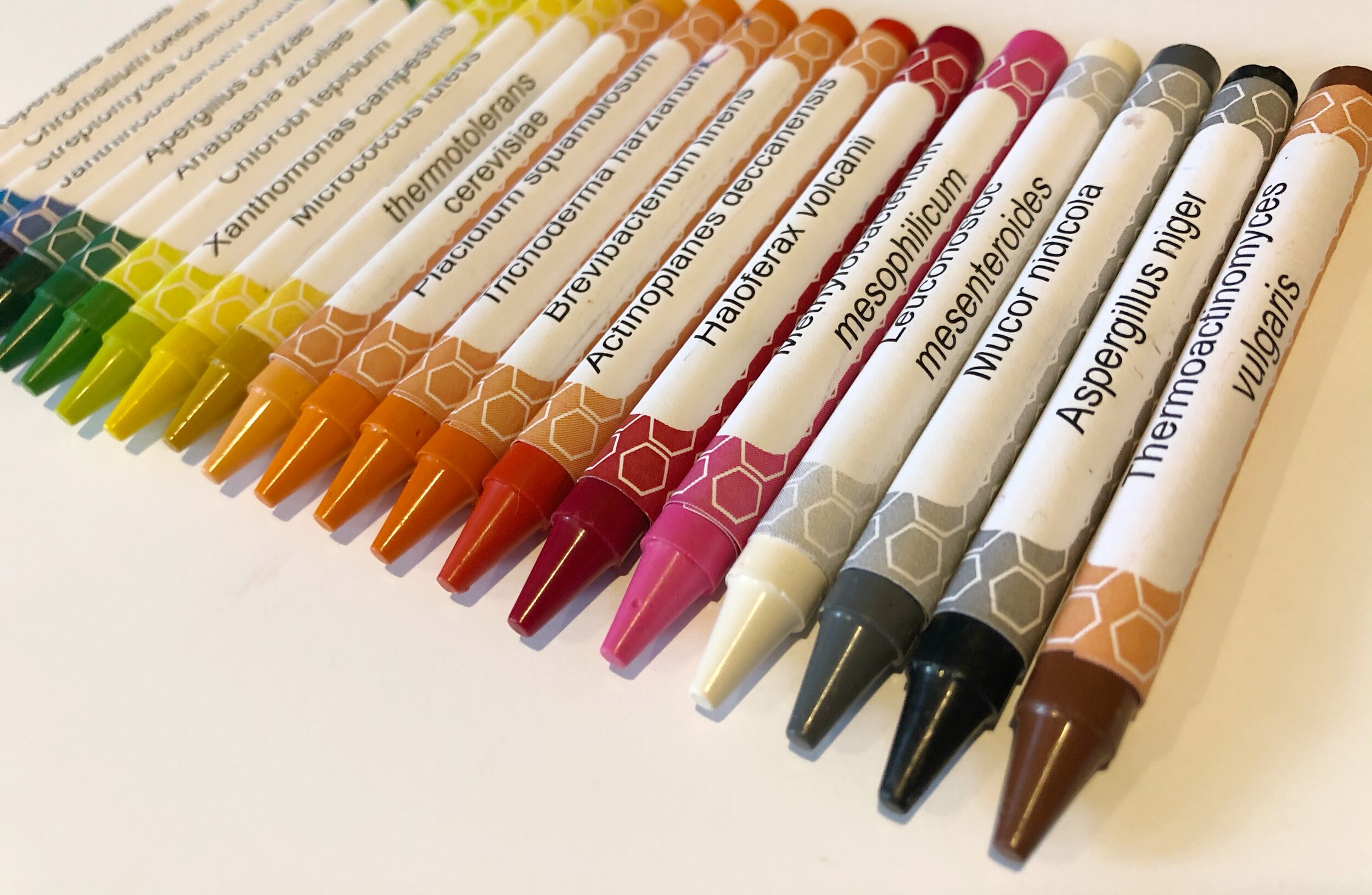
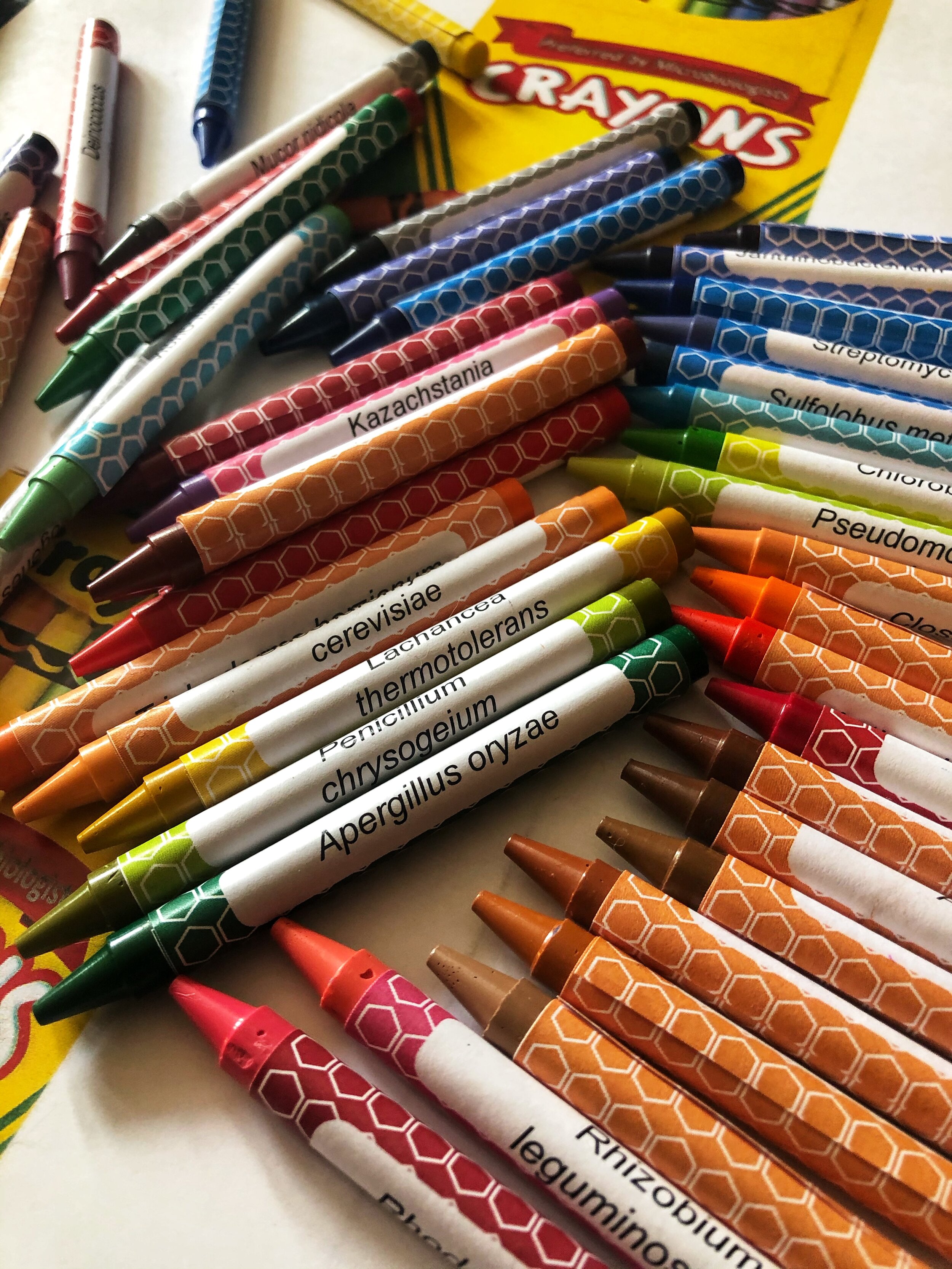
The Species Guide: Get to know the microbes on these crayon labels.
Aspergillus niger: Black. a fungus that makes black spores. It produces citric acid, which we use as a food preservative.
Mucor nidicola: White. this fungus was found living in the nest of a paper wasp. Like other species related to it, it produces oils such as DHA which can be used for infant formula supplements.
Trichoderma harzianum: Orange. a fungus that is added to plants to help protect the plants from fungal infections. When growing in the lab this fungus naturally produces a vibrant orange color.
Serratia marcescens: Red. a bacterium that can be found in our bathroom, or throughout the environment. It produces so much red pigment, it is a favorite of bioartists who use microbes to paint pictures.
Penicillium chrysogenum: Yellow Green. a fungus that makes the antibiotic Penicillin.
Photobacterium leiognathi: Blue Green. a bioluminescent bacterium that lives inside of ponyfish and helps them avoid predators.
Micrococcus luteus: Yellow. a bacterium that lives naturally on our skin, and may be the reason gym bags smell so bad. In the lab it naturally produces a bright yellow pigment and may be a future source of a living sun screen.
Brevibacterium linens: Yellow Orange. a microbe that both makes our feet stink and our cheese smell delightful. Many orange rind cheeses are orange in part due to this microbe.
Methylobacterium mesophilicum: Carnation Pink. a bacterium that can be found in the pink ooze that accumulates in our shower or toilets. It is found in nature living on plants where it can feed on molecules that are too hard for many other creatures to feast on.
Actinoplanes deccanensis: Scarlet. this bacterium lives in the soil and produces vibrant orange colors when grown on nutrients in a petri plate. It can produce antibiotics for us.
Alternaria alternata: Brown. this fungus is often found floating through the air. It is one of the major causes of fungal allergies.
Streptomyces coelicolor: Blue. this soil bacterium produces the vibrant blue antibiotic Actinorhodin. Some bioartists even use this pigment to paint with.
Saccharomyces cerevisiae: Apricot. this yeast is used to help us make beer, scotch, donuts, bread, wine, and even coffee. It is naturally found associated with insects, plant nectar, fruit, and tree sap.
Chromobacterium violaceum: Blue Violet. a bacterium found in many rivers and streams, it produces a purple compound that has been used to dye textiles.
Janthinobacterium lividum: Violet (purple). this bacterium makes a vibrant violet pigment. The pigment has anti-fungal capabilities and has been shown to be a promising cure for the deadly chytrid fungus which is wiping out the world’s amphibians.
Deinococcus radiodurans: Red Orange. microbes can live nearly everywhere, and this microbe proves that. Out of all creatures on the planet, this species is one of the best at surviving radiation.
Leptographium wushanense: Cerulean. This fungus is associated with bark beetles. It helps the beetles survive, but creates a blue/green stain in the tree associated with the blue stain disease.
Terana caerulea: Bluetiful. This is a fungus that is known as the “cobalt rust fungus.” It can be seen as giant bright blue patches on logs. It helps with decomposition.
Bacillus thuringiensis: Gray. A bacterium that can be found in the soil. This species makes the Bt toxin, a toxin that is non-toxic for humans, but when added to plants helps reduce the number of insects that feed. It is used in many organic farming practices.
Anabaena azollae: Green. this photosynthetic cyanobacteria converts light into sugars. It is typically a green color.
Chromatium okenii: Violet Red. This purple sulfur bacteria can naturally be found making decomposing plant material purpley-pink in estuaries.
Clostridium isatidis: Indigo. This bacterium is one of many that help convert plant dye into the natural indigo dye that has been used for centuries.
Pseudomonas syringae: Green Yellow. A bacterium that infects plants, it is also used to create artificial (man-made) snow at warmer temperatures.
Metchnikowia pulcherrima: Red Violet. A yeast often involved in the early stages of wine fermentation.
Other microbes featured in the original 48 pack
Lachance thermotolerans: a yeast that we found in wasps and bumblebees that is now used to create fast, scalable monoculture sour beers with honey and floral aromas.
Fusarium oxysporum: a fungus that causes plant diseases. It is known for producing vibrant pink pigments when grown on nutrients in a petri dish.
Pseudomonas aeruginosa: a bacterium that is often associated with secondary infections of the upper respiratory system. It produces a yellow-green ‘goo’ that helps it gather iron, which it needs to survive.
Bacillus licheniformis: a bacterium found on bird feathers that produces an enzyme-a molecule- that is in Tide cold water detergent. It allows us to wash clothing at colder temperatures, thereby reducing the amount of energy we use per wash by ~50%.
Vibrio fisheri: a marine bacterium that is bioluminescent. It can live inside bobtail squid and help them evade predators.
Streptomyces fradiae: a bacterium in the soil that makes the smell of fresh turned earth (geosmin). It also produces the antibiotic fosfomycin for us, this is an important antibiotic to fight of urinary tract infections.
Rhizobium leguminosarum: this bacterium lives in the nodules of clover–and other legume–roots. The nodules turn pink as the plant creates a space for the bacterium to grow, in return for getting the nitrogen fertilizer produced by the bacterium.
Streptococcus pyogenes: the bacterium that causes strep throat. By investigating the genome–genetic sequence– of this bacterium, scientists found a way to create the tool CRISPR-Cas9. This is a set of molecular scissors that is used to help scientists genetically engineer any organism they want.
Rhodotorula glutinis: This yeast produces pink pigments that are carotenoids. This is the same molecule that gives flamingos their characteristic color.
Actinoplanes deccanensis: this bacterium lives in the soil and produces vibrant orange colors when grown on nutrients in a petri plate. It can produce antibiotics for us.
Leuconostoc mesenteroides: this bacterium is a lactic acid bacteria that helps make sourdough bread taste tart. It is involved in many of our fermented foods.
Glomus aggregatum: a fungus that lives inside the roots of many plants and helps them take in nutrients.
Kazachstania barnettii: a pink yeast in some sourdough starters that helps give rise to the lovely bread.
Acetobacter xylinum: this bacterium produces nanocellulose which is used to make face masks and wound covers that are extra-hydrating. This is also one of the microbes that makes the SCOBY in kombucha.
Xanthomonas campestris: this bacterium is a deadly pathogen for plants, but in the lab it is used to make Xantham Gum, a natural food additive that is used in everything from cosmetics, to tooth paste, to Orbitz drinks.
Thermoactinomyces vulgaris: This heat loving bacterium is partially responsible for increasing the heat in compost. Some flightless birds in Australia make compost nests to help incubate their eggs.
Clostridium botulinum: This bacterium can cause the deadly botulism disease in humans, but in the lab it is the origin of the muscle paralytic Botox. Botox is used to treat sweating, headaches, and for cosmetic purposes.
Aspergillus terreus: This soil fungus can often be found clinging to your shoes, or hanging out in our house dust. It is the one of the producers of statins–the cholesterol-lowering medications that save many people’s lives ever year.
Haloferax volcanii: an archaea that can live in extremely salty environments. It is also one of the microbes that helped scientists discover the gene-editing tool, CRISPR.
Placidium squamulosum: a lichen (community of fungi and bacteria) that forms soil crusts in the desert and helps protect the soil.
Thiobacillus ferrooxidans: This bacterium is found associated with the natural chemical cycle of iron. It may be useful for bioremediation, or the clean-up of toxic waste sites.
Alcaligenese faecalis: This bacterium is found through natural environments and may be of use in helping clean up oil spills.
Chlorobi tepidum: this is a green sulfur bacteria that helps with the natural cycling of sulfur.
Sulfolobus metallicus: This archaea can live in hot and acidic conditions. It is used to help us mine copper.
Rhodococcus fascians: this is a plant pathogen that causes leafy gall syndrome.
Laccaria bicolor: This is a macroscopic fungus–where the fruiting bodies are seen as mushrooms. It is a fungus that is involved in helping plants gain access to more nutrients and resources.
Aspergillus oryzae: This fungus is used to help make sake. The fungus breaks down the sugars in rice, where yeast are then added to feed on the sugars and produce the alcohol.
Violet (purple)
Orange
Yellow Green
J. lividum photo source: Wikipedia
M. luteus photo source: Wikipedia
S. marsecens photo source: Wikipedia
Using the crayons as education tools.
Each one of these crayons helps tell a story. It introduces us to a microbe, revealing the color this microbe can make when it grows. It shares its scientific name, leading us to resources to learn more about what that species does in the world. When paired with the species guide, these crayons can help us learn about what microbes have what applications and roles in the world.
Activity 1. For each microbe, create a doodle (cartoon) that visualizes the application of this microbe. Perhaps it’s Aspergillus oryzae creating sake, or Trichoderma harzianum helping plants grow. Challenge your students to create “scientific doodles” with a relevant crayon (and microbe). Have students create theirs and then share the image in the group to see if the group can guess what the application and microbe might be.
Activity 2. Interested in learning about variations in microbial morphology? Ask your students to draw what the microbe on the crayon label would like under a microscope at x1000.
Activity 3. Interested in more categorization exercises? Ask your students to get creative with sorting the crayons to include different microbial groups: Eukaryotes versus prokaryotes, bacteria versus archaea, those involved in host symbioses, those in aquatic habitats, pathogens, or extremophiles. This integrates well with microbiology curricula related to categorizing microbes based on physiological differences (e.g., what microbes grow on certain selective media, what microbes utilize urea, etc.)
Activity 4. Go for the advanced level by asking students to make their own crayon set with new microbes. Ask them to specify the media type to have them think about differential media and plastic phenotypes. The low-cost version of this includes students making the labels and linking them to the specific crayon colors, but doesn’t require buying the crayons or printing the labels.
Visit soon for a full list of learning activities aligned with education outcomes and associated assessments!
Doodle challenge:
The microbial application of antibiotic production
Doodle challenge:
The microbial application of “Botox” (wrinkle removal)
Sorting challenge:
These microbes are all bacteria
Doodle challenge:
The microbial application of sake production
Doodle challenge:
The microbial application of plant growth enhancement
Doodle challenge:
The microbial application of the CRISPR-Cas9 system
Doodle challenge:
The microbial application of statin production
Sorting challenge:
These microbes are all fungi
